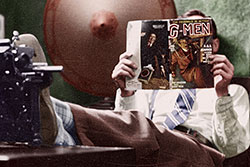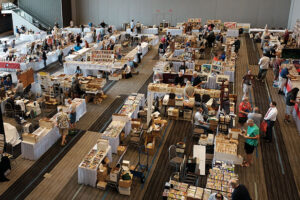 I’ve always wondered just who read the pulp magazines.
I’ve always wondered just who read the pulp magazines.
You hear comments that kids read the hero pulps, or that women read the romances, or that men read Adventure. Some of that can be correlated in the letters columns, but I like to see the numbers.
So when I was looking back through some old files last week, this tidbit from Feb. 25, 1937, caught my eye:
Men comprise 61.8 percent of the readership of pulp magazines and women 38.2 percent, according to a survey, “Who Reads the Newsprint Fiction Magazine?” released yesterday by Street & Smith Publications Inc. The study was based on interviews with 1,500 magazine buyers at newsstands in 25 cities. Of the men readers, 27.9 percent were in the 20 to 25 age class and 18 percent under 20. Among women, 26.2 percent were in the 20 to 26 age classification, with the second largest group, 20.3 percent, in the 41 to 50 age division. The median age for all readers was 27.
For many years the “all important” age demographic for the movie industry was the 18- to 25-year-old male (and may still be based on the summer’s tentpole movies). According the S&S’s survey, 47.9 percent of male pulp readers — or 29.6 percent of total readers — were in that key group.
This survey was conducted during the height of the pulp magazines’ popularity. I’d be curious to know if the demographics were different in the 1910s or ’20s, or in the 1940s.
I wish I had a copy of the complete survey results. I’m sure it would be very interesting to read.
UPDATE: I contacted the Special Collections Research Center of the Syracuse University Libraries, where the Street & Smith archives is housed. Unfortunately, they could find no evidence or reference to the survey in the archives. Maybe it will turn up somewhere else.




Fascinating stuff. I would also love to read the complete survey results.
Where does this info come from, William?
It’s from the “Advertising News” briefs in the New York Times.
I think the readership varied with each title but probably mainly men were the readers except for the love and romance titles which were almost all women. ADVENTURE in the 1920’s, more than once, mentioned wanting to attract more professional men readers like businessmen, doctors, lawyers, etc. By 1937 this may have still been true.
I know with the slick titles like SATURDAY EVENING POST, COLLIERS, etc the editors felt that they had many female readers, thus the emphasis on the romance angle in the slicks.
I’d be interested to know what the pulps’ circulation was away from the big cities. My late father said he didn’t remember seeing any for sale when he was growing up in rural Mississippi. Maybe he just overlooked them. However, the comics made their way to where he lived, so you’d think the pulps would have, too.
Whenever I can, I ask folks who would have been at a reading age during the pulp era whether they remember them. Many of them grew up in the South, of course. But so far, no one has.
Maybe folks in the larger southern cities — New Orleans, Atlanta, etc. — were more likely to have had access to them. But you do hear about people in smaller towns who clearly were aware of the pulps. Take, for instance, Robert E. Howard in a small Texas town; or Mary Elizabeth Counselman who lived most of her life in Alabama (with a period in her teenage years here in Tallahassee). But maybe they were exceptions because they were writers and were looking current reading material and for outlets for their work.
I’d be curious to know if anyone else’s parents or grandparents remember reading the pulps, and where they lived at the time.
My dad read the pulps as a teenager in Tuscaloosa, Alabama. He burned his collection before he went off to the Navy in WWII, something he regretted later. I asked him why he’d done it and he said it just seemed like the thing to do at the time. Of course, he didn’t realize they’d ever become collectible.
When I was a kid, my dad would drive me to used book stores and patiently wait while I prowled around. One time he came across some “G-8 and His Battle Aces” pulps and excitedly showed them to me. That had been his favorite. That was the first I heard of pulps. I was about 10 or 11 years old at the time and not nearly so interested in pulps as I was in The Saint books, which my dad had just introduced me to.
My wife’s father lived to be 92 and died a few years ago. He remembered the pulps and while living in the Trenton, NJ area he bought many of the general fiction titles that I collect. Looking at my collection helped him remember buying ARGOSY, ADVENTURE, BLUE BOOK. He didn’t remember anything at all about the hero pulps or SF titles.
When the pulps died in the middle fifties, he switched to the men’s adventure magazines. My wife remembers stumbling across his stash of these titles when she was little. He had them hidden away because of the risqué covers showing Nazis and half naked girls. Like most vets from the WW II era, he thought these covers were hilarious.
My father was strictly a book reader and never bothered with the pulps until a visiting nurse introduced him to the SF pulps in the early 1950’s. He had terminal cancer and was home all day reading. He was stunned at how good STARTLING was and tried to get me to read them also. But at age 9 or 10 I was not ready. However, after his death I came across them in the basement and started to read them.
I’ve heard that the pulps sold well in middle America and the small farm towns. There were very few bookstores and as a result the newsstands provided most of the reading for the farmers, etc.
Part of what we’ve forgotten about the past is how vital the railroad was. Indeed, the major periodical distributor, ANC established most of their own owned newstands (and their restaurants) at railroad stations. While Cross Plains did have a railroad I can’t say they had a newstand. However, ANC had a distribution point in the nearest big city, Abilene 44 miles away. I can’t image that an oil town like Cross Plains didnt have someone in town get a drop shipment off the railroad from Abilene. In the days before paved highways and then interstates, I would suspect a difference in towns that had a railroad pass through than those that didn’t. (oh, I’m too young to have seen pulps on my rural magazine racks – other than Ranch Romance; which we did get, as well as digest SF and mystery)..
Funny, I was thinking about this the other day. We generally agree the pulp magazines ended in the early to mid-50’s. This is also the time when the Interstate highway system came into being. Coincidence? I think not. You can read a magazine while you make the commute on a train. Not so when you’re driving a car. In Europe they still have an extensive rail system. And the Perry Rhodan series is up to, oh, 3500 installments. Doc Savage bit the dust at 181.